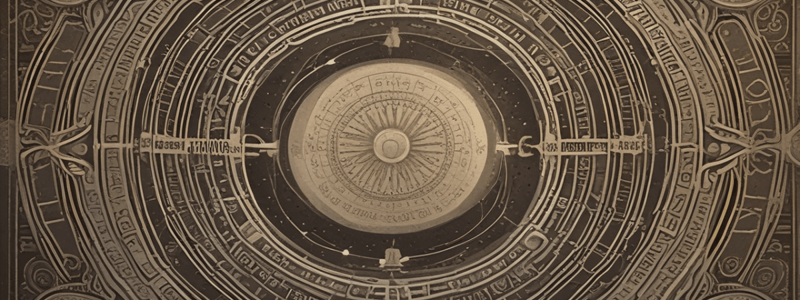Podcast
Questions and Answers
What was the basis of Numa's 355-day calendar?
What was the basis of Numa's 355-day calendar?
- Lunar cycles (correct)
- Seasonal changes
- Solar cycles
- Astrological events
Which two months were added by Numa to the original 10-month Roman calendar?
Which two months were added by Numa to the original 10-month Roman calendar?
- January and March
- January and February (correct)
- November and December
- February and April
What was the order of the original 10 months in Romulus' calendar?
What was the order of the original 10 months in Romulus' calendar?
- January to October
- March to November
- March to December (correct)
- February to November
How did Numa account for the discrepancy between the lunar and solar years?
How did Numa account for the discrepancy between the lunar and solar years?
What is the significance of Numa's revised calendar in modern times?
What is the significance of Numa's revised calendar in modern times?
What was the original length of the month of February in a leap year?
What was the original length of the month of February in a leap year?
What was the primary responsibility of the Vestal Virgins?
What was the primary responsibility of the Vestal Virgins?
Who founded the order of the Vestal Virgins in ancient Rome?
Who founded the order of the Vestal Virgins in ancient Rome?
What was the punishment for a Vestal Virgin who broke her vow of chastity?
What was the punishment for a Vestal Virgin who broke her vow of chastity?
What was the social status of the girls initially chosen to be Vestal Virgins?
What was the social status of the girls initially chosen to be Vestal Virgins?
What was the significance of the Vestal Virgins in ancient Roman society?
What was the significance of the Vestal Virgins in ancient Roman society?
When was the order of the Vestal Virgins disbanded?
When was the order of the Vestal Virgins disbanded?
Flashcards are hidden until you start studying
Study Notes
Numa Pompilius' Roman Calendar
Lunar Cycles
- Numa introduced a 355-day calendar based on lunar cycles, with an additional month added every few years to keep in sync with the solar year
- The lunar cycle was used to determine the start of the month, with the new moon marking the beginning of each month
Addition Of January And February
- Numa added two new months, January (Ianuarius) and February (Februarius), to the original 10-month Roman calendar
- January was added to the beginning of the year, and February was added to the end, creating a 12-month year
Romulus' Original 10-month Calendar
- Romulus' original calendar had only 10 months, starting with March (Martius) and ending with December (Decembris)
- The months were:
- Martius (March)
- Aprilis (April)
- Maius (May)
- Iunius (June)
- Quintilis (July)
- Sextilis (August)
- September
- October
- November
- December
Leap Year Implementation
- Numa introduced a 45-day intercalary period every few years to account for the discrepancy between the lunar and solar years
- The intercalary period was added to the end of February, making it a 23- or 24-day month in a leap year
Influence On Modern Calendars
- Numa's revised calendar laid the foundation for modern calendars, including the Julian and Gregorian calendars used today
- The addition of January and February, as well as the implementation of leap years, have been retained in modern calendars
Studying That Suits You
Use AI to generate personalized quizzes and flashcards to suit your learning preferences.




